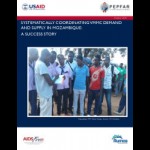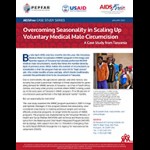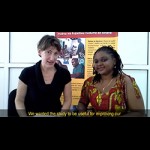Information about individual countries' efforts to scale up voluntary medical male circumcision (VMMC) for HIV prevention is provided here. For reports on progress in expanding access to VMMC services in all the priority countries, see Global updates.
Updates by country
Resources
Eswatini
This summary serves as a ”scorecard” on Eswatini's progress in key areas of HIV prevention, including voluntary medical male circumcision (VMMC).
Read moreThis video shows how workplace programmes in Swaziland are linking employees to HIV prevention services, including voluntary medical male circumcision.
Read moreEthiopia
This summary serves as a “scorecard” on Ethiopia’s progress in key areas of HIV prevention, including voluntary medical male circumcision (VMMC).
Read moreKenya
This summary serves as a ”scorecard” on Kenya’s progress in key areas of HIV prevention, including voluntary medical male circumcision (VMMC).
Read moreLesotho
This summary serves as a ”scorecard” on Lesotho’s progress in key areas of HIV prevention, including voluntary medical male circumcision (VMMC).
Read moreMalawi
This summary serves as a ”scorecard” on Lesotho’s progress in key areas of HIV prevention, including voluntary medical male circumcision (VMMC).
Read moreMozambique
This summary serves as a ”scorecard” on Mozambique’s progress in key areas of HIV prevention, including voluntary medical male circumcision (VMMC).
Read moreThis case study documents lessons learned from using a collaborative, data-driven approach to improve coordination between partners working with the Ministry of Health on the demand for and supply of voluntary medical male circumcision (VMMC) services in Mozambique’s programme.
Read moreNamibia
This summary serves as a ”scorecard” on Namibia’s progress in key areas of HIV prevention, including voluntary medical male circumcision (VMMC).
Read moreSouth Africa
This summary serves as a ”scorecard” on South Africa’s progress in key areas of HIV prevention, including voluntary medical male circumcision (VMMC).
Read moreTanzania
This summary serves as a ”scorecard” on Tanzania’s progress in key areas of HIV prevention, including voluntary medical male circumcision (VMMC).
Read moreTanzania’s VMMC programme used a combination of structural and behavioural measures to overcome men’s strong preference for seeking circumcision in the cooler months from July through August
Read moreThe success of the USAID-supported voluntary medical male circumcision (VMMC) programme in Tanzania is documented in this 13-minute film, which is narrated by Common, the US hip hop artist, poet, and actor.
Read moreThe study described in this video identified potential barriers and facilitators to adoption of male circumcision by men older than 19 in two districts of Tanzania.
Read moreUganda
This summary serves as a ”scorecard” on Uganda’s progress in key areas of HIV prevention, including voluntary medical male circumcision (VMMC).
Read moreZimbabwe
This summary serves as a ”scorecard” on Zimbabwe’s progress in key areas of HIV prevention, including voluntary medical male circumcision (VMMC).
Read more














